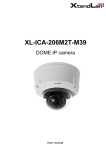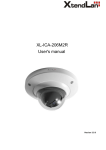Download HDD3MIA - Discount Security Cameras
Transcript
904-805-1581 HDD3MIA HD Vandal Proof IP Dome Camera User’s Manual Version 3.0.0 2 Welcome Thank you for purchasing our IP camera! This user’s manual is designed to be a reference tool for your system. Please read the following safeguard and warnings carefully before you use this series product! Please keep this user’s manual well for future reference! i Important Safeguards and Warnings 1.Electrical safety All installation and operation here should conform to your local electrical safety codes. The power shall conform to the requirement in the SELV (Safety Extra Low Voltage) and the Limited power source is rated 12V DC or 24V AC in the IEC60950-1. We assume no liability or responsibility for all the fires or electrical shock caused by improper handling or installation. We are not liable for any problems caused by unauthorized modification or attempted repair. 2.Transportation security Heavy stress, violent vibration or water splash are not allowed during transportation, storage and installation. 3.Installation Do not apply power to the camera before completing installation. Please install the proper power cut-off device during the installation connection. Always follow the instruction guide the manufacturer recommended. 4.Qualified engineers needed All the examination and repair work should be done by the qualified service engineers. We are not liable for any problems caused by unauthorized modifications or attempted repair. 5.Environment This series IP camera should be installed in a cool, dry place away from direct sunlight, inflammable, explosive substances and etc. Please keep it away from the electromagnetic radiation object and environment. Please make sure the CCD (CMOS) component is out of the radiation of the laser beam device. Otherwise it may result in CCD (CMOS) optical component damage. Please keep the sound ventilation. Do not allow the water and other liquid falling into the camera. Thunder-proof device is recommended to be adopted to better prevent thunder. The grounding holes of the product are recommended to be grounded to further enhance the reliability of the camera. 6. Daily Maintenance Please shut down the device and then unplug the power cable before you begin daily maintenance work. Do not touch the CCD (CMOS) optic component. You can use the blower to clean the dust on the lens surface. ii Always use the dry soft cloth to clean the device. If there is too much dust, please use the water to dilute the mild detergent first and then use it to clean the device. Finally use the dry cloth to clean the device. Please put the dustproof cap to protect the CCD (CMOS) component when you do not use the camera. 7. Accessories Be sure to use all the accessories recommended by manufacturer. Before installation, please open the package and check all the components are included. Contact your local retailer ASAP if something is broken in your package. Accessory Name IPC Unit MD9M data converter cable Accessories bag Quick Start Guide CD Amount 1 1 1 1 1 iii Table of Contents 1 General Introduction .................................................................................................................. 1 1.1 Overview ........................................................................................................................ 1 1.2 Features ......................................................................................................................... 1 1.3 Specifications ................................................................................................................ 2 1.3.1 Performance ........................................................................................................... 2 1.3.2 Factory Default Setup ........................................................................................... 3 2 Structure .................................................................................................................................... 11 2.1 Multiple-function Combination Cable ...................................................................... 11 2.2 Framework and Dimension ....................................................................................... 12 2.3 Bidirectional talk.......................................................................................................... 13 2.3.1 Device Connection .............................................................................................. 13 2.3.2 Operation .............................................................................................................. 13 2.4 3 4 5 Alarm Setup................................................................................................................. 13 Installation.................................................................................................................................. 15 3.1 Device Installation ...................................................................................................... 15 3.2 SD Card Installation ................................................................................................... 18 3.3 Lens Adjustment ......................................................................................................... 18 Quick Configuration ..................................................................................................... 20 4.1 Overview ......................................................................................................... 20 4.2 Operation ........................................................................................................ 20 Web Operation .......................................................................................................................... 24 5.1 Network Connection................................................................................................... 24 5.2 Login and Main Interface ........................................................................................... 24 iv 6 FAQ ............................................................................................................................................ 27 Appendix Toxic or Hazardous Materials or Elements ............................................................... 28 v 1 General Introduction 1.1 Overview This series IP camera integrates the traditional camera and network video technology. It adopts audio and video data collection, transmission together. It can connect to the network directly without any auxiliary device. This series IPC uses standard H.264 video compression technology and G.711a audio compression technology, which maximally guarantee the audio and video quality. This series IPC enclosure has the strong resistance capacity, which can guarantee the proper work performance under heavy strike. It supports real-time monitor and listening at the same time. It supports analog video output and dual-way bidirectional talk. It can be used alone or used in a network area. When it is used lonely, you can connect it to the network and then use a network client-end. Due to its multiple functions and various uses, this series IPC is widely used in many environments such office, bank, road monitor and etc. 1.2 Features User Management Different user rights for each group, one user belongs to one group. The user right shall not exceed the group right. Network Monitor Network Management Support central server backup function in accordance with your configuration and setup in alarm or schedule setting Support record via Web and the recorded file are storage in the client-end PC. Support built-in SD card. Support local SD card hot swap, support short-time storage when encounter disconnection. Real-time respond to external local alarm input and video detect as user predefined activation setup and exert corresponding message in screen and audio prompt(allow user to pre-record audio file) Real-time video detect: motion detect, camera masking. Can generate an alarm when network abnormal, SD card abnormal event occurred. IPC supports one-channel audio/video data transmit to network terminal and then decode. Delay is within 270ms (network bandwidth support needed) Max supports 20 connections. Adopt the following audio and video transmission protocol: HTTP, TCP, UDP, MULTICAST, RTP/RTCP, RTSP and etc. Support web access, widely used in WAN. Realize IPC configuration and management via Ethernet. Support device management via web or client-end. Support various network protocols. Support the on-off alarm device to alarm via the sound or the light. Power External power adapter DC12V/AC 24V Support PoE. Assistant Function Log function Support PAL/NTSC Storage Function Alarm Function Peripheral Equipment 1 Support system resource information and running status real-time display. Day/Night mode auto switch (ICR switch). Built-in IR light. Support IR night vision (For HDBW Series only). Backlight compensation: screen auto split to realize backlight compensation to adjust the bright. Support electronic shutter and gain setup. Support video watermark function to avoid vicious video modification. 1.3 Specifications 1.3.1 Performance System Please refer to the following sheet for IPC performance specification. Model HDD3MIA Series Parameter Main TI Davinci high performance DSP Processor OS Embedded LINUX System Support real-time network, local record, and remote operation at the same Resources time. User Interface Remote operation interface such as WEB, DSS, PSS System Status SD card status, bit stream statistics, log, and software version. Video Parameter Image Sensor 1/2.8-inch CMOS Pixel Day/Night Mode Auto Iris Gain Control 2048(H)*1536(V) White Balance Manual/Auto BLC Manual/Auto Manual/Auto PAL: It ranges from 1/3 to 1/10000. NTSC: It ranges from 1/4 to 1/10000. Electronic Shutter Support day/night mode switch and IR-CUT at the same time. DC drive Fixed/Auto Video Compression Standard H264/JPEG/MJPEG Video Frame Rate PAL: Main stream(2048*1536@15fps) extra stream,(704*576@15fps) Main stream(1920*1080@25fps) extra stream(704*576@25fps) NTSC: Main stream(2048*1536@15fps) extra stream(704×480@15fps) Main stream(1920*1080@30fps) extra stream(704×480@30fps) Video Bit Rate Video Flip Snapshot Privacy Mask Video Setup H.264: 56Kbps-8192Kbps. MJPEG is adjustable and bit rate is adjustable. Support customized setup. Support mirror. Support flip function. Max 1f/s snapshot. File extension name is JPEG. Supports max 4 privacy mask zones Support parameter setup such as bright, contrast. 2 Audio Video Information Lens Lens Interface Audio Input Audio Output Bidirectional Talk Input Audio Bit Rate Audio Compression Standard Video Motion Detect Video Loss Alarm Input Record and Backup Record Priority Channel title, time title, motion detect, privacy mask. [email protected] CS. Lens is the default accessories 1-channel,RCA audio input. 1-channel, RCA, audio output. Reuse the first audio input channel 16kbps 16bit G.711a/G.711u/PCM 396 (18*22) detection zones;sensitivity level ranges from 1 to 6 (The 6th level has the highest sensitivity) Activation event, alarm device, audio/video storage, image snapshot, log, email function and etc. Activation event, alarm device, audio/video storage, image snapshot, log, email function and etc. 2-channel input,1-channel output Manual>External alarm >Video detect>Schedule Local Storage Wire Network Support Micro SD card storage Network AUX Interface General Parameter Remote Operation Video Output Reset 1-channel wire Ethernet port, 10/100 Base-T Ethernet Standard HTTP, TCP/IP, IPv4/IPv6, ARP, IGMP, ICMP, RTSP, RTP, UDP, SMTP, FTP, DHCP, DNS, DDNS, PPPOE, UPNP, NTP, Bonjour, SNMP, NFS. Monitor, system setup, file download, log information, maintenance , upgrade and etc 1-channel analog video output,BNC port, 9-pin port connection 6-pin port connection IR light 35 LED, IR distance 10 to 20 meters (For HDBW series product only) Power Power Consumption Working Temperature Working Humidify Dimensions(m m) Weight Installation Support AC24V/DC12V power. PoE Network Protocol 7W MAX -10℃~+60℃ 10%~90% ¢160x118.5 1.25g Support various installation modes(Enclosure and bracket is optional) 1.3.2 Factory Default Setup Please refer to the following sheet for factory default setup information. Function Setup Type Item Default setup HDD3MIA Con ditio ns Ca mer a Setu p Brightness 50 Contrast 50 3 Function Setup Type Default setup Item HDD3MIA Hue 50 Saturation 50 Gain mode Auto Gain limit 80 Exposure mode Auto Auto iris Enable Scene mode Auto Day/night mode Auto BLC Off Flip Disable Video Bit stream type General Encode mode H.264B Resolution Main stream Video stream bit Extra stream 1080P (1920*1080) Frame rate (FPS) PAL: 25 NTSC:30 Bit stream type CBR Reference bit rate 3584-8192 Kb/S Bit rate 8192 I frame interval 50 Watermark settings Enable Watermark character DigitalCCTV Enable Enable Bit stream type General Encode mode H.264B Resolution CIF(352×288/35 2×240) Frame rate (FPS) PAL: 25 NTSC:30 Bit rate type CBR Reference bit rate 192-1024Kb/S Bit rate 640 I frame interval 50 720P(1280*72 0) CIF(352×288/3 52×240) 4 Function Setup Type Default setup Item Snapshot Overlay Path Audio Main stream Sub(Extra) stream TCP/IP Network setup Connection PPPoE HDD3MIA Snap type General snap Image size 1080P (1920*1080) 720P(1280*7 20) Quality Better Interval 7s Privacy mask Enable Channel title Enable Time title Enable Snapshot path C:\PictureDownload Record path C:\RecordDownload Enable Enable Encode mode G.711A Enable Disable Encode mode G.711A Host name IPC Ethernet card Wire(Default) Mode Static MAC address Depends on the device IP version IPV4 IP address 192.168.1.168 Subnet mask 255.255.255.0 Default gateway 192.168.1.1 Preferred DNS 8.8.8.8 Alternate DNS 8.8.8.8 Enable ARP/Pingto to set IP address service Enable Max connection 10 TCP port 37777 UDP port 37778 HTTP port 80 RTSP port 554 Enable Disable 5 Function Setup Type Default setup Item DDNS IP filter SMTP(email) UPnP SNMP Bonjour Multicast HDD3MIA User name N/A Password N/A Server type Disable ,CN99 DDNS Server IP none Port 80 Domain name none User name none Password N/A Update period 5m Trusted sites Disable SMTP server none Port 25 Anonymity Disable User name anonymity Password N/A Sender none Authenticatio n (Encrypt mode) N/A Title (Subject) IPC Message Main Receiver N/A Interval 0s Health email Disable ,interval=60m Enable UPnP Disable SNMP v1 Disable SNMP v2 Disable SNMP port 161 Read community public Write community private Trap address N/A Trap port 162 Enable Enable Server name “Device name+SN”. Depends on the device. Multicast address 239.255.42.42 Port 36666 6 Function Setup Type Default setup Item HDD3MIA Enable Disable SN 1 Server IP 0.0.0.0 Port 7000 Sub-device ID none WIFI On(Enable) Enable QoS Real-time monitor 0 Command 0 Enable Disable Anti-dither 5 seconds Sensitivity 3 Record Channel Enable Record Delay 10 seconds Relay (Alarm) output Enable Alarm delay 10s Send email Disable PTZ Disable Activation N/A Address 0 Snapshot Disable Enable Disable Record Channel Enable Record Delay 10 seconds Relay out Enable Record Delay 10 seconds Send email Disable PTZ Disable Activation Disable Address 0 Snapshot Disable Enable Disable Relay input Alarm1 Anti-dither 5s Sensor type NO Auto register Motion detect Video detect Video (Camera) masking Event management Relay (Alarm) activation Alarm setup 7 Function Setup Type Default setup Item HDD3MIA Record channel Enable Record delay 10s Relay (Alarm) output Enable Relay (Alarm) delay 10s Send email Disable PTZ Disable Activation N/A Address 0 Snapshot Disable Relay output No SD card Capacity warning Abnormity (Alarm) 1 SD card error Disconnection Enable Disable Relay (Alarm) output Enable Relay output delay 10s Send email Disable Enable Disable Capacity limit (Space threshold) 10% Relay (Alarm) output Enable Relay output delay 10s Send email Disable Enable Disable Relay (Alarm) output Enable Relay output delay 10s Send email Disable Enable Disable Record Enable Record delay 10s Relay (Alarm) output Enable Relay output 10s 8 Function Setup Type Default setup Item HDD3MIA delay IP conflict FT P Destination(Storag e) Network storage Storage management Conditions control) (Record Local setup General setup Date and time System management Enable Disable Record Enable Record delay 10s Relay (Alarm) output Enable Relay output delay 10s FTP enable Disable Server IP N/A Port 21 User name anonymity Password N/A Remote storage path share Emergency storage to local path Disable NAS enable Disable Mode NFS Server IP N/A Port 21 User name N/A Password N/A Remote storage path N/A Pack duration 8m Pre-record 5s Disk full Overwrite Record mode Auto Device name Device factory SN Language English Video standard NTSC Date format Y-M-D Time format 24H Time zone GMT+08:00 Current time Sync PC DST Disable DTS type Week NTSC 9 Function Setup Type Default setup Item PTZ setup Auto maintenance HDD3MIA Start time 00:00:00 of the first Sunday of the month End time 00:00:00 of the second Monday of the month Synchronize with NTP Disable NTP server clock.isc.org Port 37 Update period 10m Protocol PELCOD Address 1 Baud rate 9600 Data bit 8 Stop bit 1 Parity N/A Auto reboot Enable Auto delete old files Disable 10 2 Structure 2.1 Multiple-function Combination Cable You can refer to the following figure for multiple-function combination cable information. See Figure 2-1. Figure 2-1 Please refer to the following sheet for detailed information. Port Name Function Connection Note VIDEO OUT Video port output BNC Output analog video signal. It can connect to the TV monitor to view the video. AUDIO IN Audio port input RCA Input audio signal. It can receive the analog audio signal from the pickup. AUDIO OUT Audio port output RCA Output audio signal to the devices such as the sound box. 12V DC/AC24V Power port input / Power port. Input DC 12V/AC 24V I/O I/O cable port / Connect to I/O port cable. LAN Network port Ethernet port Connect to standard Ethernet cable. Support PoE. Please refer to the follow sheet for detailed information of MD9M data converter cable. Port Name I/O Pin Cable Color Name Note Red ALARM_COM Alarm output public port. Brown ALARM_IN1 Alarm input port 1. It is to receive the on-off signal from the external alarm source. Port 11 Port Name Cable Color Name Note Grey ALARM_IN2 Alarm input port 2. It is to receive the on-off signal from the external alarm source. Alarm output port. It is to output the alarm signal to the alarm device. White ALARM_NO NO: normal open alarm output port. It works with the ALARM_COM port. It is to restore factory default setup. Blue RESET Orange GND When the device is working properly, please connect the blue cable (restore default setup port) to the orange cable (GND signal) for 5 seconds, the device can resume factory default setup. Ground port 2.2 Framework and Dimension Please refer to the following two figures for dimension information. The unit is mm. See Figure 2-2 and Figure 2-3. Figure 2-2 12 Figure 2-3 2.3 Bidirectional talk 2.3.1 Device Connection Before the operation, connect the active pickup to the audio input port of the device. Connect the active speaker to the audio output port of the device. Please make sure the client-end device has the audio input and output function. For example, you need to connect the microphone and then earphone to the PC if you want to implement the bidirectional talk function. 2.3.2 Operation Login the Web and click the bidirectional talk button to enable this function. Click this button again; you can close current bidirectional talk. 2.4 Alarm Setup The alarm interface is shown as in Figure 2-4. Please follow the steps listed below for local alarm input and output connection. 1) Connect the alarm input device to the alarm input port (grey or brown pin of I/O port cable). 2) Connect the alarm output device to the alarm output port (White-pin) and alarm output public port (Red-pin). The alarm output port supports NO (normal open) alarm device only. 3) Open the Web, go to the Figure 2-4. Please set the alarm input 01 port for the brown-pin (the 1st channel) of I/O port cable. The alarm input 02 is for the grey-pin (the 2nd channel) of I/O port cable. Then you can select the corresponding type (NO/NC.) 4) Set the WEB alarm output. The alarm output port of the alarm output 01 device (The white-pin of the I/O port cable). 13 Figure 2-4 14 3 Installation This series IPC can be put on the table to realize surveillance. Or you can use the bracket or the inceiling installation to realize the hang function. Please refer to the steps listed below. 3.1 Device Installation Step 1 Use the inner hexagonal wrench (provided) to loose the three inner hexagon screws in the dome cover and then open the cover. The device is shown as in Figure 3-1 Figure 3-1 Step 2 Use the inner hexagonal wrench (provided) to loose the three inner hexagon screws in the dome and then remove the device pedestal. See Figure 3-2 . With IR light Without IR light Figure 3-2 15 Step 3 Draw out the cable exit and four screw holes in the installation position according to the device pedestal. Dig the four plastic expansion bolt holes and cable exit. Insert the four plastic expansion bolts into the screw holes Step 4 Adjust the camera pedestal to the proper position and then draw the cable through the cable exit you just dug in the ceiling (wall). Line up the four screw holes in the device pedestal to the four plastic expansion bolt holes in the installation position. Put the four self-tapping screws in the device pedestal and then use the screwdriver to secure the screws in the four plastic expansion bolts firmly. Step 5 Adjust the device position and line up the three inner hexagon screws of the device to the three holes of the installation position. Put the three inner hexagon screws into the screw holes at the bottom of the pedestal. Use the inner hexagon screwdriver to fix firmly. Connect the GND to the ground wires to improve stability. See Figure 3-3 . With IR light Without IR light Figure 3-3 Step 6 Adjust the X-Y-Z axis module to turn the device to the proper monitor angle. Please follow the steps listed below to adjust. See Figure 3-4. Please note, for the dome of the IR light, you can skip step a) and step e). a): Slightly push the two sides to squeeze the plastic hook so that you can take off the dome enclosure. b):Slightly loose the screws at the two sides of the X-Y-Z module manually, you can adjust the module tilt rotation angle (15°~90°). c):Slightly loose the screw of the pressing slice, you can adjust the video rotation angle of the module (0°~355°) d):Adjust the turning ring of the pedestal, you can adjust the module pan rotation angle (0°~ 355°). 16 e): Put the enclose back after you completed the setup. With IR light Without IR light Figure 3-4 Please note, the screws in the following figure are the optical adjustment component. Please make sure it is outward and do not allow it to touch the X-Y-Z axis module. See Figure 3-5 Figure 3-5 Step 7 Put the dome cover back and then put the three inner hexagon screws into the holes of the device. Use the inner hexagonal wrench to fasten these three screws. See Figure 3-6 Figure 3-6 17 3.2 SD Card Installation Important Before you install the SD card, please unplug he power cable to shut down the device! First, please refer to the step1 in the chapter 3.1 to open the device. Second, please adjust the proper position to install the SD card. Last, please refer to the step 7 in the chapter 3.1 to complete the installation. See Figure 3-7. With IR light Without IR light Figure 3-7 3.3 Lens Adjustment Step 1 Slightly loose the screw B manually and then turn the screw B slowly. Adjust the lens focus distance to the proper position according to the monitor video. See Figure 3-8. Step 2 Use the flat screwdriver to loose the screw A slightly and then turn the Screw A slowly. Adjust the lens focus to get the clear video and then use the flat screwdriver to secure the screw firmly. Step 3 When you are adjusting the screw A, the video may becomes blur. Please slightly adjust the screw B manually to get the vivid video. Finally fix the screw. 18 With IR light Without IR light Figure 3-8 19 4 Quick Configuration 4.1 Overview Quick configuration can search current IP address, modify IP address. Please note the search only applies to the IP addresses in the same segment. 4.2 Operation Run the Hybrid NDVR, click the “Menu” button on the bottom right corner, select “Add/Del IP camera”, and click “IPC search”, you’ll see an interface shown in Figure 4-1. Figure 4-1 Select “DH series IPC search”, you can view device IP address, data port number, subnet mask, default gateway, MAC address and etc. See in Figure 4-2, click on one device and its detailed information will be shown there. . 20 Figure 4-2 Select one IP address and then click “Add to DVR”, then “Exit”, you can see an interface shown in Figure4-3. Figure 4-3 21 After camera added, right click on it and select the “IP camera setup” item; you can go to the configuration interface. If you want to modify the device IP address without logging in the device web interface, you can go to the software interface to set. In Figure 4-2, you can view device IP address, user name, password and port. Please modify the corresponding information to login. Click the “IE setup”, then you can login to the web interface. 22 Figure 4-5 Please note to login with HTTP port (Default 80) in web client and Data port (Default 37777) in software. Otherwise, you cannot login the device. For detailed information and operation instruction of the quick configuration tool, please refer to the IP_System_Quick_Start_Guide. 23 5 Web Operation This series IPC product support the Web access and management via PC. Web includes several modules includes monitor channel preview, PTZ control, system configuration, alarm and etc. IP camera factory default setup: IP address: 192.168.1.108. User name: admin Password: admin 5.1 Network Connection Please follow the steps listed below for network connection. Make sure the IPC has connected to the network properly. Please set the IP address, subnet mask and gateway of the PC and the IPC respectively. IPC default IP address is 192.168.1.108. Subnet mask is 255.255.255.0. Gateway is 192.168.1.1 Use order ping ***.***.***.***(* IP camera address) to check connection is OK or not. 5.2 Login and Main Interface Open IE and input IP camera address in the address bar. For example, if your camera IP is 192.168.1.108, then please input http:// 192.168.1.108 in IE address bar. See Figure 5-1. Input your IP address here Figure 5-1 The login interface is shown as below. See Figure 5-2. Please input your user name and password. Default factory name is admin and password is admin. Note: For security reasons, please modify your password after you first login. 24 Figure 5-2 If it is your first time to login in, system pops up warning information to ask you whether install control webrec.cab or not after you logged in for one minute. Please click OK button, system can automatically install the control. When system is upgrading, it can overwrite the previous Web too. If you can’t download the ActiveX file, please check whether you have installed the plug-in to disable the control download. Or you can lower the IE security level. See Figure 5-3. Figure 5-3 After you logged in, you can see the main window. See Figure 5-4. 25 Figure 5-4 Please refer to the Web Operation Manual included in the resource CD for detailed operation instruction. 26 6 FAQ Bug I cannot boot up the device. Please click RESET button for at least five seconds to restore factory default setup. SD card times Do not set the SD card as the storage media to storage the schedule record file. It may damage the SD card duration. write I cannot use the disk as the storage media. When disk information is shown as hibernation or capacity is 0, please format it first (Via Web). I cannot upgrade the device via network. When network upgrade operation failed, you can use port 3800 to continue upgrade. Recommended SD card brand Kingston 4GB, Kingston 1GB, Kingston 16GB, Transcend 16GB, SanDisk 1G, SanDisk 4G. Usually we recommend the 4GB (or higher) or industry-level high speed card in case the slow speed results in data loss. Audio function Please use active device for the audio monitor input, otherwise there is no audio in the client-end. The lightproof ring of the IR device The lightproof ring of the IR device lens is the necessary component when it works. You cannot view the clear video when the IR light is on if you remove the lightproof ring. 27 Appendix Toxic or Hazardous Materials or Elements Toxic or Hazardous Materials or Elements Component Name Pb Hg Cd Cr VI PBB PBDE Circuit Board Component ○ ○ ○ ○ ○ ○ Device Construction Material ○ ○ ○ ○ ○ ○ Wire and Cable ○ ○ ○ ○ ○ ○ Packing Components Accessories ○ ○ ○ ○ ○ ○ ○ ○ ○ ○ ○ ○ O: Indicates that the concentration of the hazardous substance in all homogeneous materials in the parts is below the relevant threshold of the SJ/T11363-2006 standard. X: Indicates that the concentration of the hazardous substance of at least one of all homogeneous materials in the parts is above the relevant threshold of the SJ/T11363-2006 standard. During the environmental-friendly use period (EFUP) period, the toxic or hazardous substance or elements contained in products will not leak or mutate so that the use of these (substances or elements) will not result in any severe environmental pollution, any bodily injury or damage to any assets. The consumer is not authorized to process such kind of substances or elements, please return to the corresponding local authorities to process according to your local government statutes。 Note This user’s manual is for reference only. Slight difference may be found in user interface. All the designs and software here are subject to change without prior written notice. If there is any uncertainty or controversy, please refer to the final explanation of us. Please visit our website for more information. 28
















































